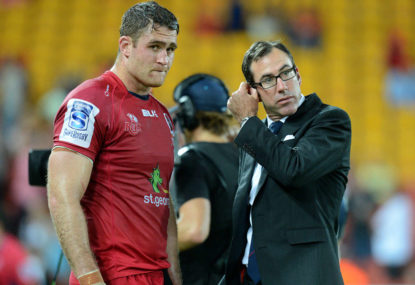Empires rise and empires fall. And so it is with rugby.
In 1962 Queensland Rugby was held in such contempt by the Waratahs, that NSW refused to play them.
This snub was never forgotten by Queensland, and it lit the fire that raged within the hearts of the Queensland Rugby administration and fanned by the late Coach Bob Templeton for almost 20 years.
It did so to the point where Queensland rugby improved so much that in the early 80s it was considered to be the best provincial rugby team in the world. It rose to beat the mighty All Blacks 9-3 in 1980 and crush NSW 1-7 in 1982, the centenary year of these interstate clashes.
This Saturday the Queensland Reds face their arch enemy, NSW, hoping to get their Super Rugby campaign back on track – but also hoping to live up to the feats of those great Queensland teams of the 80s that tore through the Waratahs like tissue paper.
It is a simply matter of pride.
The fire that burnt so strongly way back then still rages in the modern era – and none more so than when Queensland has its back to the wall.
From the heady days in 2011 when the Reds rose to the majestic heights of the Super Rugby Championship they now find themselves coming off a disastrous 2014 season where they finished 13th and a shaky 2015, plagued with injuries and unnecessary and annoying off-field distractions.
They have drawn a line in the sand and drawn inspiration from the greats of yesteryearas they face the reigning 2015 Super Rugby champions.
If the Waratahs take this game lightly, they do so at their own peril.
On paper – it looks like the Waratahs have the guns to blow the Reds off the park.
But that’s not the way rugby works and if this Reds team has anything – it has courage.
Richard Graham’s game plan needs to be simply this – put the toughest 15 players out on the field on Saturday night and belt NSW into submission.
Forget the tactical substitutions and all the other rubbish that has become part of modern rugby.
Queensland needs to find their toughest men and leave them out on the field for 80 minutes – with a take-no-prisoners attitude and the mental fortitude and physical strength to back this up.
Queensland rugby league’s Maroons understands this mentality very well, and overcome the odds time and time again.
Ironically, when Queensland rugby union was at its zenith in the early 80s that team was called the ‘Mighty Maroons’.
The great NRL rugby league coach Wayne Bennett was interviewed by Wally Lewis on Wednesday night and made two simple observations:
• If you want to win run straight and tackle.
• Great teams are predictable.
In those halcyon days of the 80s, the Queensland rugby team was indeed predictable.
NSW’s fullback Glen De Vanzo told me years ago that there was nothing worse than coming to Queensland and playing them at Ballymore.
NSW knew exactly what Queensland were going to do – but felt powerless to stop it. As soon as Queensland won the ball, they would pass it to their mercurial five-eighth Paul Mclean who would put up a majestic ‘garryowen’ falling with pinpoint accuracy just outside the Waratah’s 22 metre line.
De Vanzo could hear the Queensland forwards come rampaging towards him – as he watched McLean’s high ball pierce the skies before it fell back to earth – and there was nothing he could do about it.
He had no option but to try and catch the ball – in the knowledge that if he did catch it – the mighty marauding Maroons pack would hit him as soon as he touched the ball (you could hit a man in mid air in those days), drive him to the ground and trample him into dust until they secured the ball.
You could also ruck way back then.
This would set Queensland up deep in NSW territory to launch attacking raids on NSW’s line until the Queensland wingers – the brilliant Brendan Moon and mercurial Peter Grigg – would finish the job off and score.
Then what did Queensland do? They went back to halfway and repeated the process.
Predictable – and ruthlessly effective.
In those days, to be removed from the field would be the ultimate dishonour – barring serious injury.
Conversely, to be on the field was the greatest feeling in the world – the team was tight and tough. Prepared to take on anyone at any time at any place – and never lie down.
As they said way back then – no-one was going to die wondering.
Today, it seems that some players have difficulty playing for 80 minutes.
Consider NSW giant lock Will Skelton – the biggest man in Australian Rugby – who never appears to be left on the field for a full game. I would love to see this big man play a full game of rugby. There’s just so much potential.
It raises the question: if he is not fit enough, why isn’t he? And if he is fit enough – why doesn’t he play for 80 minutes?
Imagine the coach telling the Irish rugby supporters that their lock Paul O’Connell would only be used as an impact player or New Zealand Supporters that Brad Thorn couldn’t last the distance, or South Africans that Victor Matfield was only good for half a game.
Here’s a novel idea for Saturday night’s annual derby between the Reds and the Waratahs – let’s put 15 players from each side out on the pitch for 80 minutes and keep them there to fight it out (subject to injury).
Last man standing stuff.
Rugby has certainly changed over the years – but one thing that hasn’t changed is this – the toughest team usually wins.
It’s for this reason that I am backing the Reds to pull off an upset.





























































































